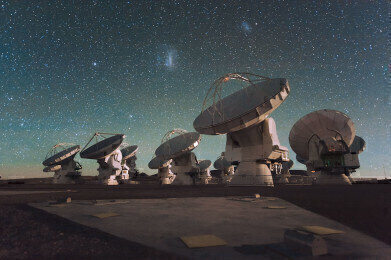-
 The Atacama Large Millimeter/submillimeter Array (ALMA) by night, under the Magellanic Clouds (Credit: ESO)
The Atacama Large Millimeter/submillimeter Array (ALMA) by night, under the Magellanic Clouds (Credit: ESO)
News
Scientists celebrate completion of ALMA
Apr 05 2013
Scientists around the world have celebrated the monumental achievement of the completion of ALMA – the most complex ground-based telescope in existence. The telescope was officially opened during an inauguration ceremony in Chile, the result of two decades of work from institutions all over the world.
ALMA is a high-frequency radio telescope made up of 66 individual antennas; these are combined to create a telescope with an effective diameter of up to 16 kilometres. It will show us never-before seen details, in the millimetre and sub-millimetre wavelengths it sees, about the birth of stars and planets, and of infant galaxies in the early Universe. It will also discover and measure the distribution of molecules – many essential for life – that form in the space between stars.
Able to observe the Universe by detecting light that is invisible to the human eye, ALMA will show us never-before-seen details about the birth of stars, infant galaxies in the early Universe, and planets coalescing around distant suns. It also will discover and measure the distribution of molecules — many essential for life — that form in the space between the stars.
The observatory was conceived as three separate projects in Europe, USA and Japan in the 1980s, and merged to one in the 1990s. Construction started in 2003. The total construction cost of ALMA is approximately US$ 1.4 billion, of which ESO’s share is 37.5%.
Digital Edition
Lab Asia Dec 2025
December 2025
Chromatography Articles- Cutting-edge sample preparation tools help laboratories to stay ahead of the curveMass Spectrometry & Spectroscopy Articles- Unlocking the complexity of metabolomics: Pushi...
View all digital editions
Events
Jan 21 2026 Tokyo, Japan
Jan 28 2026 Tokyo, Japan
Jan 29 2026 New Delhi, India
Feb 07 2026 Boston, MA, USA
Asia Pharma Expo/Asia Lab Expo
Feb 12 2026 Dhaka, Bangladesh


















